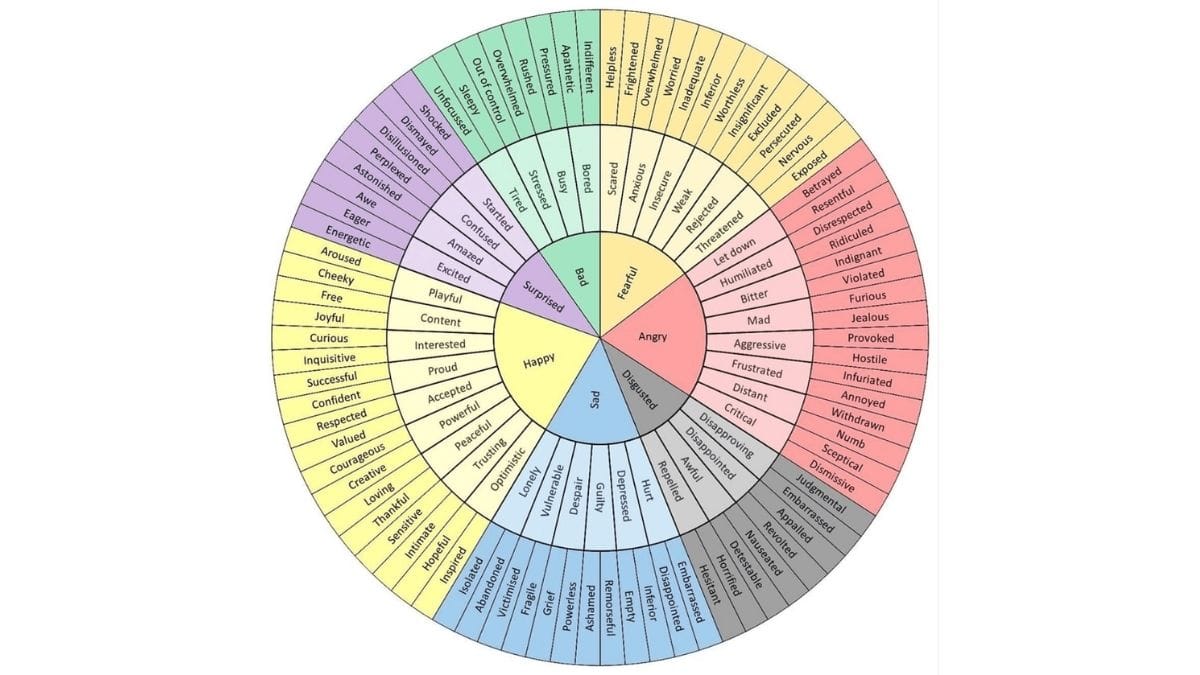The Emotion Wheel: 8 Primary Emotion, Benefits and Use

The emotion and feeling wheel is a psychological tool, a circular graphic representation of emotions designed to help people easily identify and understand the specifics of their emotional state.
The emotions are divided into sections and subsections. This tool allows people to identify and name their feelings accurately. The emotion wheel helps in managing emotions more effectively, which often leads to better outcomes.
The 8 Core Emotions
- Trust
- Anticipation
- Fear
- Disgust
- Surprise
- Sadness
- Anger
- Joy
Combining Core Emotions
Life is full of disappointments and delights, and emotions are different partly because they arise out of emotion blending.
Secondary emotions result from the combination of two primary emotions.
These are some examples=
- Anger + Anticipation = Aggressiveness
- Anticipation + Joy= Optimism
- Disgust + Anger= Contempt
- Fear + Surprise= Awe
- Joy + Trust= Love
- Sadness + Disgust= Remorse
- Surprise + Sadness= Disapproval
- Trust + Fear= Submission
In addition to providing information about each emotion, it also provides its contrasting emotion so you can see where certain feelings sit on the spectrum. We gain a deeper understanding of our feelings when we see our emotions displayed with their opposites on the emotion wheel.
- Fear is the contrasting emotion of anger
- Anticipation is the contrasting emotion of surprise
- Surprise is the contrasting emotion of anticipation
- Trust is the contrasting emotion of disgust
- Disgust is the contrasting emotion of trust
- Fear is the contrasting emotion of anger
- Joy is the contrasting emotion of sadness
- Sadness is the contrasting emotion of joy
Benefits of emotion wheel may include-
- Taking a step from self-denial to self-acceptance.
- Acquiring the ability to explain yourself to others and understand others.
- Introspecting and understanding past actions.
- Keeping emotions under control especially if there are stressful times or interpersonal conflict.
- Taking care of your own needs and standing up for yourself
- Getting to a point where you’re not as reactive to emotional triggers.
- Developing your understanding of other people’s perspectives
- Teach others (especially adolescents) the importance of emotional intelligence
Here are a few ideas to use the emotional wheel-
Using the emotion and feeling wheel, you can discuss the highs and lows of each member of your family when everyone sits down together. As a result, you’ll gain a deeper understanding of what your children have been through and normalize the interaction of talking about real feelings rather than using the easy or default response. By using the emotion wheel you show children how to process and communicate their emotions while giving them an opportunity to share without feeling threatened.
Children (teenagers) may go through phases when they are more sensitive or prone to aggression. One-on-one discussions might be helpful to shed light on the shift. Guide and teach them to identify themselves by using the emotion wheel. Emotions that are bottled up tend to explode. Before an explosion occurs, talking to someone can help prevent damage by allowing them to deal with their emotions before they are forced to.
Your children might not act out in the same way as the “blown up” type, but that doesn’t mean all is well inside. Consider pursuing and checking in with your children if they seem quiet or isolated. By referring to the emotional wheel, they can begin to understand what they may be feeling. Often people are not able to comprehend what’s going on inside them until they are given the words, particularly in situations where the emotions expressed are similar.
Different people react differently to situations, and our emotional reactions are no different. We can pinpoint a common shared experience by being specific in the way we express our emotions. This will allow us to better understand what each other may be feeling. When you empathize with your child’s situation, it allows them to feel accepted, even if they don’t agree.
Even though this may seem like a drastic shift from your family’s norm and may even feel awkward at first. Think about how it would be like for everyone in your family to be able to express themselves freely and communicate. It could open up a whole new world of communication within the family not only to be able to understand each other but also to know how to care for one another.
Feeling strange when checking in with your feelings can be an indicator that you haven’t been adequately supported in expressing your true self. Self-awareness and acceptance require effort, but the rewards are priceless.
The emotion wheel awaits you!



